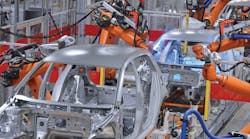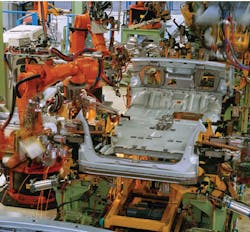In the mid-90s, it was hard to pick up a newspaper, magazine or attend a distributor association meeting without getting a double-barrel blast of Internet Brouhaha. At the time, I was skeptical. Even though I consider myself to be an early adopter of things technical, I would have bet big money the amazing promises would never transpire. Today’s world of internet driven TV, phones, streaming music and social media continue to astound me on a daily basis. Reviewing the current technology landscape, I suspect I am about to be flabbergasted, again.
According to Rockwell Automation’s chairman, Keith Nosbusch (a guy positioned to know), “Industry operations will change more radically in the next 10 years than they have in the last 50 years.” Considering the past four decades brought us the PLC, AC drives, smart motor starters, touchscreen human-interface devices and a laundry list of computerized devices, this statement says a lot.
One of the drivers of this Tsunami of change is the interaction, merger and meshing of smart devices on the factory floor with standard internet networks and systems. This phenomenon carries a number of brand-centric names. Rockwell Automation refers to it as the “Connected Enterprise.” Siemens and others use “Industry 4.0.” Generically, our customers refer to the whole thing as the Industrial Internet of Things (IIoT).
Running parallel to the generic Internet of Things which promises a future of smart refrigerators sending us messages when we’re down to our last cold bottle of brew or smart garage doors opening as we round the corner, IIoT technology is the marriage of real-time connectivity throughout the manufacturing world.
To give you a flavor for the explosive scope and size of this time bomb of technology: Wim Elfrink, Cisco’s chief globalization officer, said more than 300,000 new devices are being connected to the internet every hour. What’s more, Cisco research points out 34% are finding their way into the manufacturing sector.
Don’t look for a product or products carrying the name Industrial Internet of Things. Instead, expect a transformational change with the convergence of technologies including the internet, mobile devices, the cloud and connection of plant information with enterprise systems. It will be a commingled world of IT and control systems. This new reality is about more than just faster machinery on the shop floor.
The point is, this isn’t just about automation products. Certainly, automation has already played a major role in manufacturing with massive improvements in speed, quality and machine uptime. IIoT is focused on how we can provide the right information, at the right time, to make better business decisions and improve the use of increasingly scarce human resources such as control engineers and technicians.
Manufacturers see much to gain by the employment of the Internet of things. Back in 2012, experts said the Internet of Everything would be worth $14.4 trillion over the next 10 years; that it had the potential the potential to drive global profits upward by 22%; and that it’s a combination of efficiencies in asset utilization, employee productivity, supply chain/logistics, customer experience and innovation. They said all of this would happen by 2022.
Today, in spite of the current industrial slowdown, the experts remain bullish. With this massive potential for growth, one can only wonder why more companies haven’t positioned themselves as early adopters in the IIoT movement. Customer surveys indicate the two most common concerns are cost and security. Thinking back at the economically damaging security breaches like Target’s fiasco where critical data on over 70 million of its customers was lost, it doesn’t take a rocket scientist to understand why this is important. The good news is the technology of internet security is moving forward at breakneck speed. I see opportunity for electrical distributors. The looming issue is how do we provide value for our customers? Our customers are interested in making their first move. They’re very interested, but most don’t know where to start.
The low-hanging fruit. The best start is with a well-known, easy to identify and definable issue because a common problem allows for group input and agreed-upon measures of success. Further, if the metrics involve dollars, we address the critical concern of implementation cost. A measurable payback trumps price.
One very well-known issue in the automation world comes via remote access of automation equipment. For years, engineers have understood the potential of making small program adjustments to machines from remote locations. But meaningful troubleshooting or major programming changes were just out of reach. Technology shortfalls played a part in limiting the potential value of the work. Phone lines were slow and subject to interruption and internet-based technology opened the customer to security issues. Solutions were cobbled together but required massive IT department involvement and were often dismissed as too much hassle to try.
Fortunately, breakthroughs in the convergence of new technologies can allow more secure connections. At the same time, Ethernet connections have quietly appeared on everything from drive and motion-control systems to encoders and machine guarding equipment (and lighting). On an unrelated front, web-based cameras can also allow engineers at a remote location to verify movement, and machine vision allows dimensions to be checked from afar.
In my mind, remote access is a great launching point for the Industrial Internet of Things journey.
An example of IIoT technology that enables the remote-access application can be found in the system developed by Belgian company, eWON. Combining the power of mobile devices, the cloud and a unique piece of internet hardware, eWON addresses the remote access of automation equipment problem.
Using this system allows an engineer in downtown Tupelo to monitor, troubleshoot and modify automation equipment in Tokyo, Toronto and Taipei without boarding a plane.
Quantifying success for customers. Measures of success are easy to understand. The first and simplest measure could be number of trips required to a facility to keep a machine running. For OEMs and systems integrators, trips made to machines early in their implementation stage are numerous, Many companies report an easy half dozen field trips made to fine tune the machine processes. Often these involve two days of travel to conduct two hours of work.
Another easy measure is the uptime of the machine. Typically, maintenance makes the first pass at the machine and then escalates the issue to someone with a bit more experience. After another attempt to fix the issue locally, the team may call an offsite expert. More time is lost as the group is given a series of suggestions for a fix. Finally, after the loss of what can be nearly a full day of production and after all else fails, a request for remote support is made. Machine uptime and productivity are again lost to travel time (often a full day) and scheduling.
Machine availability and productivity would be easy to not only measure but to document. Financial measures of success are the real proof. Even a short trip can be expensive. Last minute air fares, rental car expenses, motels and incidentals push the cost of an average field trip into the $2,000 to 3,000 range, and this cost does not include the cost of the engineer’s lost time. In spite of advancements in productivity tools, most engineers find it difficult to be effective while rushing from one plane to another in a busy airport. With the burdened cost of a journeyman control engineer ranging in the $70 to $100 per hour range, losing a couple of days work brings the total to closer to $4,000 per occurrence.
None of the costs previously mentioned include lost productivity. While an hour of downtime can carry a price tag of thousands of dollars, in some industries a lost day equates to disaster. One case in point is a vegetable producer with limited shelf life between picking and packing.
As Rockwell Automation likes to say, “At the end of the day it’s about competitiveness.” That means the company that can produce more, minimize scrap, eliminate waste and produce more with fewer resources wins.
Launching innovative thinking around the IIoT. New technology seems to whet the human appetite for exploration. Some will be happy with remote connectivity and they will take the technology to as far as remote programming allows. Others will use it to innovate. To give you an idea of how this innovation takes place, here’s a story from a real-world situation.
One OEM client of eWON applied the technology to a family of metal-forming machines used on construction sites. The original plan called for the eWON device to be used purely for remote troubleshooting, but things grew from there. A number of the OEM’s customers lease the machines. The lease arrangements are built around the number of parts produced. For years this required a manual report sent back to the company headquarters. Once there, a paper report was routed to accounting and billing done.
This manual process had lots of glitches. Information arrived late, was lost in the mail, or improperly handled once it arrived. Not everyone involved read the report, and sometimes the fact that the report was filled out on a potentially dirty job site affected the information in the report.
Innovation happens. Someone asked why the eWON units couldn’t be used to automatically provide billing data on a leased machine. Today, the reports are auto-generated and sent directly to the accounting office for billing — no paper, no mail hassles, no late reports and best yet no human interface required. The big guys call this bridging the gap between systems, and the customer calls this good business.
What’s the message for electrical wholesalers? First, IIoT is a reality not a pipe-dream. eWON has reported over four million remote connections using their devices and the number is growing exponentially. (Close to 100% of these sales were made by distributors.) Secondly, the best sales are both easy for the customer to define and measure success. Our sellers don’t do well with pie in the sky sorts of conceptual selling.
Finally, and thinking strategically, if distributors don’t carve out a position for themselves in this exploding new market, others channels will. This technology falls at the crux of electrical, automation and IT domains. We used the example of automation, but IIoT will play a role in lighting, metering, circuit protection and safety. Those who fail to put their toe in the water will miss the opportunity.
Frank Hurtte provides strategic insight for new times. He speaks and consults on the new reality facing distribution in a post-recession world. Contact Frank at River Heights Consulting via email at [email protected] or via phone at 563-514-1104.












